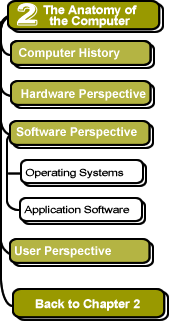

|
Operating Systems: MS-DOS
The difficult nature of using early operating systems was an obstacle to the average person attempting to use a computer. Early operating systems were designed with computer programmers in mind: to interact with a computer's hardware components or to execute software programs, one had to learn cryptic, difficult commands and type them in response to a "prompt." This is called a "command-line interface."
MS-DOS (aka "DOS," which rhymes with boss), the operating system developed by Microsoft for the IBM PC, had a command-line interface. For example, the DOS command to get a list of files stored on a one of the computer's disk was DIR (short for "directory"). To execute this command, one had to enter it in response to the "DOS prompt" ("C:\>" in the example below) :

Alternatively, to clear the screen, one entered "CLS" at the DOS prompt.

And so on and so on. Computer programmers may have been accustomed to the need to learn such an esoteric vocabulary, but most users disliked the DOS command-line interface. Many likened it to having to learn a foreign language just to do basic computer operations: it just wasn't worth it.
![]()
![]()
These pages were written by Steven H. VanderLeest and Jeffrey Nyhoff and edited by Nancy Zylstra
©2005 Calvin University (formerly Calvin College), All Rights Reserved
If you encounter technical errors, contact computing@calvin.edu.